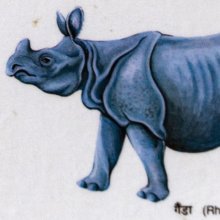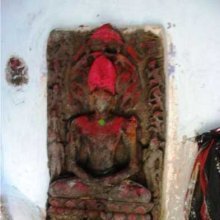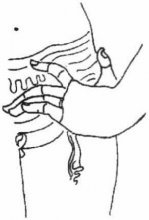Gada, Gadā, Gadam, Gadavane, Gadhavane: 46 definitions
Introduction:
Gada means something in Buddhism, Pali, Hinduism, Sanskrit, Marathi, Jainism, Prakrit, Hindi, biology. If you want to know the exact meaning, history, etymology or English translation of this term then check out the descriptions on this page. Add your comment or reference to a book if you want to contribute to this summary article.
Alternative spellings of this word include Gaad.
Images (photo gallery)
(+14 more images available)
In Hinduism
Pancaratra (worship of Nārāyaṇa)
Source: Wisdom Library: PāñcarātraGadā (गदा, “mace”):—One of the nine symbols representing the cosmic principles of the universe, according to the Pāñcarātra literature. These nine weapons and ornaments symbolize the principles which they represent as the presiding deity. The Mace (gadā) represent Mahat (‘cosmic intelligence’).
Source: archive.org: Isvara Samhita Vol 5Gadā (गदा) or Gadāmudrā is the name of a mudrā described in the Īśvarasaṃhitā 35-36.—Accordingly, “forming the fist with the right hand upon the thumb of the left thumb it shall be shown auspicious Kaumodakī. It is known gadāmudrā, which would crush an army of defects”. Mūdra (eg., Gadā-mudrā) is so called as it gives joy to the tattvas in the form of karman for those who offer spotless worship, drive out the defects which move about within and without and sealing up of what is done.
Source: SriMatham: Vaiṣṇava Iconology based on Pañcarātra ĀgamaThe Mace (gadā):—
buddhirapyāste gadārūpeṅa mādhave ||
“The mace which Kṛṣṇ wields is the Intellect.” (V.P. 1;22;68.)
The mace is the form of strength or power and the intellect is the highest power, by the power of mind one person can control thousands. The mace is thus the symbol of the intellect (buddhi) or the power of knowledge.
Source: Shodhganga: Kasyapa Samhita—Text on Visha Chikitsa (p)gadā ca kālikā sākṣāt sarvaśatrunibarhiṇī |
“The mace is Kali, the power of time, and it destroys everything that opposes it.” (K.U. 23)
Gadā (गदा) refers to a “mace” and represents one of the attributes of Garuḍa, according to the second chapter of the Kāśyapa Saṃhitā: an ancient Sanskrit text from the Pāñcarātra tradition dealing with both Tantra and Viṣacikitsā (Toxicology).—Accordingly, text text dictates that a Garuḍa-upāsaka, the aspirant, must meditate on Garuḍa of the following form—[...] Garuḍa, seated on a lotus, adorned with these ornaments [i.e., the eight divine serpents], has huge wings and immense energy. Garuḍa of smiling countenance, blazes with eight shoulders adorned by the weapons—conch, discus, nectar-pot, serpent, mace (gadā), and sword and two hands reaching out to the feet of the Lord.

Pancaratra (पाञ्चरात्र, pāñcarātra) represents a tradition of Hinduism where Narayana is revered and worshipped. Closeley related to Vaishnavism, the Pancaratra literature includes various Agamas and tantras incorporating many Vaishnava philosophies.
Shilpashastra (iconography)
Source: Google Books: Elements of Hindu iconographyGadā is the ordinary Indian club. It is held in the hand by the images with all the five fingers. In some cases, however, one of the hands of the image is placed upon the top of the gadā which rests on the floor. In the earlier sculptures, its representation is always plain; it has a tapering top and a stout bottom. In comparatively later instances, it is more or less elaborately ornamented. It is a weapon meant to strike the enemy at close quarters and does not therefore leave the hand of its owner.
Source: Red Zambala: Hindu Icons and Symbols | TrinityThe mace (gadā) held in Viṣṇu’s lower left hand is the form of strength or power, and the intellect is the highest power, by the power of mind one person can control thousands. The mace is thus the symbol of the intellect (buddhi) or the power of knowledge.
The mace as a symbol of sovereignty also indicates the law of Karma by which all humans are governed.
Source: Red Zambala: Hindu Icons and Symbols | IntroductionGadā (mace) - Primarily a symbol of Vishnu but also shared among many of the deities. The mace is a symbol of sovereignty and the Cosmic Order. It also symbolises Karma, the law of cause and effect.
Source: Shodhganga: The significance of the mūla-beras (śilpa)Gadā (गदा) refers to “club” or “mace” and represents one of the several “attributes” (āyudha) or “accessories” of a detiy commonly seen depicted in Hindu iconography, defined according to texts dealing with śilpa (arts and crafs), known as śilpaśāstras.—Gadā is the ordinary Indian club. It is held in the hand with all the five fingers. In some cases, however, one of the hands of the image is placed upon the top of the gadā which rests on the floor. It has a tapering top and a stout bottom. It is a weapon meant to strike the enemy at close quarters and does not therefore leave the hand of its owner.
Source: Shodhganga: Vaisnava Agamas And Visnu ImagesGadā (गदा) refers to one of the various attributes (āyudha) of divine icons, as defined in treatises such as the Pāñcarātra, Pādmasaṃhitā and Vaikhānasa-āgamas, extensively dealing with the technical features of temple art, iconography and architecture in Vaishnavism.—The four attributes viz., śaṅkha, cakra, gadā and padma are very essential in the Pāñcarātra mode of worship. As per Vihagendrasaṃhitā (2.25b-26a), the four attributes i.e., padma, cakra, gadā and śaṅkha signify the creation (sṛṣṭi). sustenance (sthiti), dissolution (laya) and eternal liberation (mokṣa) respectively.
Gadā, in personified form has the complexion of golden mountain; he is plendour and has lotus-like eyes; she illuminate the pan of the sky with the rays emanating from her, thus describes Sātvatasaṃhitā (13.11b-12a). Marīci describes gadā of Viṣṇu viz. Kaumodakī in female form. This two-armed one has golden or red complexion and red clothes. She holds gadā on her bead.
Gadā must be on the left side where the palm is turned downside like kaṭihasta. Pādmasaṃhitā (Kriyāpāda 20.80-81a) describes: gadā must be of four tala of the length. The broader portion should be at the bottom and the thin portion should be at the top and must be held in the upturned palm of the lower left hand. The broader portion has to be three aṅgulas and thinner portion is one aṅgula and madhyama should be two and half aṅgulas. Pādmasaṃhitā (Kriyāpāda 20.81b) says, while holding gadā, the distance between the waist and palm must be two aṅgulas. Nāradīyasaṃhitā (13.182a) informs that the broader (bulbous) end of gadā must rest on the edge of the pīṭha, i.e. on the top of karṇika of the padmapīṭha, in the standing icon.

Shilpashastra (शिल्पशास्त्र, śilpaśāstra) represents the ancient Indian science (shastra) of creative arts (shilpa) such as sculpture, iconography and painting. Closely related to Vastushastra (architecture), they often share the same literature.
Vastushastra (architecture)
Source: Wisdom Library: Vāstu-śāstraGadā (गदा):—The Sanskrit name for a classification of a ‘temple’, according to the Agnipurāṇa, featuring a list of 45 temple types. It is listed under the group named Triviṣṭapa, featuring octagonal-shaped temples. This list represents the classification of temples in North-India.

Vastushastra (वास्तुशास्त्र, vāstuśāstra) refers to the ancient Indian science (shastra) of architecture (vastu), dealing with topics such architecture, sculpture, town-building, fort building and various other constructions. Vastu also deals with the philosophy of the architectural relation with the cosmic universe.
Dharmashastra (religious law)
Source: Google Books: Manusmṛti with the ManubhāṣyaGada (गद, “illness”) is meant to indicate other kinds of disability also; so that due cognizance should be taken of such conditions also as family troubles, fear of creditor and so forth. (See the Manubhāṣya verse 8.107)

Dharmashastra (धर्मशास्त्र, dharmaśāstra) contains the instructions (shastra) regarding religious conduct of livelihood (dharma), ceremonies, jurisprudence (study of law) and more. It is categorized as smriti, an important and authoritative selection of books dealing with the Hindu lifestyle.
Purana and Itihasa (epic history)
Source: archive.org: Puranic Encyclopedia1) Gadā (गदा).—A weapon. An asura called Gada was born to Kaśyapaprajāpati by his wife Diti. Viṣṇu killed Gada, and Viśvakarman made a weapon with his bone. Since the weapon was made from Gada’s bone it came to be known as Gadā. (Agni Purāṇa, Chapter 114).
2) Gada (गद).—A brother (Yādava) of Balabhadrarāma. General. Vasudeva had, besides Devakī, seven wives called Rohiṇī, Bhadrā, Mālinī, Madirā, Ilā, Rocanā and Pauravī, and out of the seven Rohiṇī had six sons called Balabhadrarāma, Gada, Sāraṇa, Durdama, Vikala and Kṛta. (Bhāgavata, Navama Skandha). Other details.
2) Gada was present at the svayaṃvara of Draupadī. (Ādi Parva, Chapter 185, Verse 32).
2) On the marriage of Arjuna with Subhadrā, it was Gada who brought the dowry of Subhadrā from Dvārakā to Indraprastha. (Ādi Parva, Chapter 220, Verse 32).
2) When Śrī Kṛṣṇa came to Dvārakā Gada received him with embraces. (Mahābhārata Sabhā Parva, Chapter 2, Verse 35).
2) Gada also was present on the occasion when the Pāṇḍavas first stepped into the beautiful palace built for them by Maya at Indraprastha. (Mahābhārata Sabhā Parva, Chapter 4, Verse 39).
2) Along with the other Yādavas Gada too was present at the rājasūya yajña of Yudhiṣṭhira. (Mahābhārata Sabhā Parva, Chapter 34, Verse 16).
2) Gada held a prominent position among the Yādavas deputed to guard Dvārakā against the onslaught of King Sālva. (Mahābhārata Vana Parva, Chapter 15, Verse 9).
2) Gada also accompanied Śrī Kṛṣṇa to the Aśvamedha yajña performed by Yudhiṣṭhira. (Aśvamedha Parva, Chapter 86, Verse 9).
2) Śrī Kṛṣṇa felt uncontrollably angry when Gada was attacked during the mutual fighting with iron rods by the Yādavas which climaxed in their total annihilation. (Mausala Parva, Chapter 3, Verse 45).
3) Gada (गद).—See Gada.
Source: archive.org: Shiva Purana - English Translation1) Gadā (गदा) refers to weapons given to Kārttikeya (son of Śiva); i.e., the “mace” was given by Kubera and the “club” was given by Kāma, according to the Śivapurāṇa 2.4.5 (“Kārttikeya is crowned”).—Accordingly, after the Kṛttikās spoke to Kārttikeya: “[...] Then Śiva, the lord of the universe, following the worldly convention delightedly placed Kārttikeya on a beautiful gemset throne. [...] Agni lovingly gave him a spear; Nirṛti his own weapon and the wind his own weapon. Kubera gave him a mace (gadā); Śiva a spear; the gods different kinds of weapons and implements. The delighted lord of Kāma gave him the weapon of love, a club (gadā) and his own lore with great pleasure. [...]”.
2) Gadā (गदा) refers to the “mace” (of Viṣṇu), according to the Śivapurāṇa 2.5.17 (“The fight between Viṣṇu and Jalandhara”).—Accordingly, as Sanatkumāra narrated to Vyāsa: “[...] Then a great battle ensued between Viṣṇu and Jalandhara, the ruler of Asuras, both filling up the sky with their arrows. [...] With his bow split, the lord Viṣṇu, protector of the worlds, hurled his great mace (sva-gadā) for the destruction of Jalandhara. That mace resembling a blazing flame when hurled by Viṣṇu moved with unerring aim and dashed against his body. Though hit by it, the great haughty Jalandhara did not move even slightly as though he was hit by a flower-garland. [...]”.
Source: Cologne Digital Sanskrit Dictionaries: The Purana Index1a) Gada (गद).—A son of Kṛṣṇa1 who was stationed at the western gate of Mathurā for defence.2 Had a place on the left detachment of Kṛṣṇa's army. When Jarāsandha attacked Mathurā for a third time, Gada played a heroic part.3 Attacked Caidya party which pursued Kṛṣṇa taking away Rukmiṇī.4 Went with Vṛṣṇis to the city of Bāṇa.5 Accompanied Sāmba and others to play and came across a huge lizard in a well and reported it to Kṛṣṇa.6 Took part in defending Dvārakā against Śālva and in expelling his forces.7 Went to Syamantapañcaka for solar eclipse.8 At Prabhāsa.9
- 1) Bhāgavata-purāṇa I. 14. 28: II. 3. 19: III. 1. 35: IV. 23. 12: X. 41. 32: 47. 40: 52. 40: 59. 10: XI. 30. 16.
- 2) Ib. X. 50. 20 [4].
- 3) Ib. [50 (V) 11]: [51 (V) 25].
- 4) Ib. 54. 6.
- 5) Ib. 63. 3.
- 6) Ib. 64. 12 [1-4].
- 7) Ib. X. 76. 14: 77. 4.
- 8) Ib. 82. 6.
- 9) Ib. XI. 30. 16.
1b) A son of Vasudeva and Rohiṇī.*
- * Bhāgavata-purāṇa IX. 24. 46.
1c) A son of Vasudeva and Devarakṣitā.*
- * Bhāgavata-purāṇa IX. 24. 52.
1d) Art and science of, learnt by Duryodhana from Balarāma;1 a war weapon.2
1e) An Asura, stronger than Vajrāyudha, gave his bone to Brahmā on the latter's request; Viśvakarman made it a gada.*
- * Vāyu-purāṇa 109. 3-4.
1f) A son of Bhadrā and Vasudeva.*
- * Viṣṇu-purāṇa IV. 15. 24.
2a) Gadā (गदा).—A votary of Kṛṣṇa.*
- * Bhāgavata-purāṇa III. 1. 35: Vāyu-purāṇa 55. 12. 109. 4 and 11.
2b) Mace of Viṣṇu.*
- * Viṣṇu-purāṇa IV. 15. 13: V. 34. 23.
Gada (गद) is a name mentioned in the Mahābhārata (cf. I.177.16) and represents one of the many proper names used for people and places. Note: The Mahābhārata (mentioning Gada) is a Sanskrit epic poem consisting of 100,000 ślokas (metrical verses) and is over 2000 years old.
Gada also refers to the name of a Weapon mentioned in the Mahābhārata (cf. II.31.15, III.48.24, IX.44.104).
Source: Wisdomlib Libary: The Brahmāṇḍa-purāṇaGadā (गदा) refers to “maces” and represents one of the various weapons equipped by the Daityas in their war against Lalitā, according to the Brahmāṇḍa-purāṇa 4.22. Accordingly, “[...] thereupon, crores of Daityas producing reverberating chattering noise furiously prepared themselves (to fight) against Parameśvarī (Lalitā). [...] Crores of Daityas were fully equipped with coats of mail and had the following weapons and missiles in their hands [viz.: Gadās (maces)], and thousands of similar weapons and missiles very dreadful and capable of destroying living beings”.

The Purana (पुराण, purāṇas) refers to Sanskrit literature preserving ancient India’s vast cultural history, including historical legends, religious ceremonies, various arts and sciences. The eighteen mahapuranas total over 400,000 shlokas (metrical couplets) and date to at least several centuries BCE.
Dhanurveda (science of warfare)
Source: Wisdom Library: DhanurvedaGadā (गदा) refers to a weapon (“mace”). It is a Sanskrit word defined in the Dhanurveda-saṃhitā, which contains a list of no less than 117 weapons. The Dhanurveda-saṃhitā is said to have been composed by the sage Vasiṣṭha, who in turn transmitted it trough a tradition of sages, which can eventually be traced to Śiva and Brahmā.

Dhanurveda (धनुर्वेद) refers to the “knowledge of warfare” and, as an upaveda, is associated with the Ṛgveda. It contains instructions on warfare, archery and ancient Indian martial arts, dating back to the 2nd-3rd millennium BCE.
Natyashastra (theatrics and dramaturgy)
Source: Wisdom Library: Nāṭya-śāstraGada (गद) refers to the “mace”, a weapon which should measure should measure four tālas (unit of measurement), according to Nāṭyaśāstra chapter 23. In dramatic plays, weapons such as gada should be made by experts using proper measurements and given to persons engaged in a fight, angry conflict or siege. It forms a component of āhāryābhinaya (extraneous representation).

Natyashastra (नाट्यशास्त्र, nāṭyaśāstra) refers to both the ancient Indian tradition (shastra) of performing arts, (natya—theatrics, drama, dance, music), as well as the name of a Sanskrit work dealing with these subjects. It also teaches the rules for composing Dramatic plays (nataka), construction and performance of Theater, and Poetic works (kavya).
Vyakarana (Sanskrit grammar)
Source: Wikisource: A dictionary of Sanskrit grammarGadā (गदा).—A popular name given to the scholarly commentary written by Vaidyanātha Pāyaguṇḍe on the Paribhāṣenduśekhara. The commentary is called काशिका (kāśikā) also, as it was written in the town of Kāśī (Vārāṇasī).

Vyakarana (व्याकरण, vyākaraṇa) refers to Sanskrit grammar and represents one of the six additional sciences (vedanga) to be studied along with the Vedas. Vyakarana concerns itself with the rules of Sanskrit grammar and linguistic analysis in order to establish the correct context of words and sentences.
Shaivism (Shaiva philosophy)
Source: Shodhganga: Temple management in the ĀgamasGadā (गदा) refers to one of the various Devatā weapons and represents a type of “temple implement (instrument)” as described in the Karaṇalakṣaṇavidhi-paṭala section of the Uttara-Kāmikāgama.—The instruments should be according to the particular śāstra followed at the temple. Some of the instruments mentioned are weapons of all Devatās including [viz., gadā].

Shaiva (शैव, śaiva) or Shaivism (śaivism) represents a tradition of Hinduism worshiping Shiva as the supreme being. Closely related to Shaktism, Shaiva literature includes a range of scriptures, including Tantras, while the root of this tradition may be traced back to the ancient Vedas.
Shaktism (Shakta philosophy)
Source: Google Books: ManthanabhairavatantramGadā (गदा, “mace”) (cf. Gadāpāṇi) refers to one of the attributes of Viṣṇu, according to the second recension of the Yogakhaṇḍa of the Manthānabhairavatantra, a vast sprawling work that belongs to a corpus of Tantric texts concerned with the worship of the goddess Kubjikā.—Accordingly: “[...] Then, after the goddess Kumārikā had heard Vyāsa’s words, she hid her Māyā nature from him and assumed (her) Vaiṣṇava form. Viṣṇu held a conch, discus, mace (gadā) and rosary [śaṅkhacakragadāpāṇiḥ akṣasūtraṃ]. Stainless (nirañjana), he wore yellow clothes and, mounted on Garuḍa, he was radiant. Keśava, that is, Janārdhaka, was accompanied by Mahālakṣmī. (He), the god Hari, born from a lotus womb, is the imperishable cause (of all things). [...]”.

Shakta (शाक्त, śākta) or Shaktism (śāktism) represents a tradition of Hinduism where the Goddess (Devi) is revered and worshipped. Shakta literature includes a range of scriptures, including various Agamas and Tantras, although its roots may be traced back to the Vedas.
Jyotisha (astronomy and astrology)
Source: Wisdom Library: Brihat Samhita by VarahamihiraGada (गद) refers to “disease”, according the Bṛhatsaṃhitā (chapter 7), an encyclopedic Sanskrit work written by Varāhamihira mainly focusing on the science of ancient Indian astronomy astronomy (Jyotiṣa).—Accordingly, “If Mercury should, after his conjunction with the Sun, reappear in the month of Āṣāḍha or Śrāvaṇa or Vaiśākha or Māgha, there will be fear in the land; but if he should be in his course in those months there will be happiness in the land. If Mercury should so reappear in the month of Kārttika or Aśvayuja, there will be wars in the land and mankind will suffer from robbers, from fire, from disease [i.e., gada-bhaya], from flood and from hunger”.

Jyotisha (ज्योतिष, jyotiṣa or jyotish) refers to ‘astronomy’ or “Vedic astrology” and represents the fifth of the six Vedangas (additional sciences to be studied along with the Vedas). Jyotisha concerns itself with the study and prediction of the movements of celestial bodies, in order to calculate the auspicious time for rituals and ceremonies.
Mantrashastra (the science of Mantras)
Source: Shodhganga: Kasyapa Samhita—Text on Visha Chikitsa (mantra)Gadā (गदा, “mace”) or Gadāmudrā refers to one of the Pañcamudrās (“five mudrās or signs”), according to the Śeṣa-samhitā (p.26, mudrāvidhi).—Mantras refers to “that which is chanted by people to obtain their spiritual aspirations”. Mantras must be accompanied by the prescribed mudrās or signs. Mudrā is the position of the hand and finger indicative of various moods and sentiments, and accelerate the effectiveness of the accompanying mantras. The Śeṣasamhitā states that the five Mudrās [e.g., mace (gadā-mudrā)] yield the four puruṣārthas when displayed in the middle and end of a japa.
Mantrashastra (शिल्पशास्त्र, mantraśāstra) refers to the ancient Indian science of mantras—chants, incantations, spells, magical hymns, etc. Mantra Sastra literature includes many ancient books dealing with the methods reciting mantras, identifying and purifying its defects and the science behind uttering or chanting syllables.
In Buddhism
Tibetan Buddhism (Vajrayana or tantric Buddhism)
Source: Wisdom Library: Tibetan BuddhismGada (गद) refers to one of the male Vidyā-beings mentioned as attending the teachings in the 6th century Mañjuśrīmūlakalpa: one of the largest Kriyā Tantras devoted to Mañjuśrī (the Bodhisattva of wisdom) representing an encyclopedia of knowledge primarily concerned with ritualistic elements in Buddhism. The teachings in this text originate from Mañjuśrī and were taught to and by Buddha Śākyamuni in the presence of a large audience (including Gada).
Source: OSU Press: Cakrasamvara SamadhiGadā (गदा) refers to a “mace”, according to the Cakrasaṃvara Samādhi [i.e., Cakrasamvara Meditation] ritual often performed in combination with the Cakrasaṃvara Samādhi, which refers to the primary pūjā and sādhanā practice of Newah Mahāyāna-Vajrayāna Buddhists in Nepal.—Accordingly, “By the form of a skull cup, and by the letter Māṃ, Vāruṇī, Eighteen arms, one face, red color, and three eyes, A sword, arrow and hook, on the right, a skull cup, ax and banner, Thus a mace (gadā), thus a bell, and in the ninth, granting wishes, A two-headed drum, a bow and noose, a staff and a water pot, A trident, hammer and lute, and thus a number, in the upper hand, A young adolescent beauty, a great beauty, a beautiful goddess”.

Tibetan Buddhism includes schools such as Nyingma, Kadampa, Kagyu and Gelug. Their primary canon of literature is divided in two broad categories: The Kangyur, which consists of Buddha’s words, and the Tengyur, which includes commentaries from various sources. Esotericism and tantra techniques (vajrayāna) are collected indepently.
Biology (plants and animals)
Source: Wisdom Library: Local Names of Plants and DrugsGada in the Telugu language is the name of a plant identified with Diospyros sylvatica Roxb. from the Ebenaceae (Ebony) family. For the possible medicinal usage of gada, you can check this page for potential sources and references, although be aware that any some or none of the side-effects may not be mentioned here, wether they be harmful or beneficial to health.
Gada in the Telugu language, ibid. previous identification.
Gada in the Santal language is the name of a plant identified with Salix tetrasperma Roxb. from the Salicaceae (Willow) family.
Source: Google Books: CRC World Dictionary (Regional names)1) Gada in India is the name of a plant defined with Careya arborea in various botanical sources. This page contains potential references in Ayurveda, modern medicine, and other folk traditions or local practices It has the synonym Barringtonia arborea (Roxb.) F. Muell. (among others).
2) Gada is also identified with Catunaregam spinosa It has the synonym Randia dumetorum (Retz.) Lam. (etc.).
3) Gada is also identified with Randia spinosa It has the synonym Randia spinosa (Jacq.) H. Karst., nom. illeg. (etc.).
4) Gada is also identified with Saussurea costus It has the synonym Aplotaxis lappa Decaisne (etc.).
5) Gada in Nepal is also identified with Jatropha curcas It has the synonym Ricinoides americana Garsault (etc.).
Example references for further research on medicinal uses or toxicity (see latin names for full list):
· Florae Columbiae terrarumque adjacentium specimina selecta in peregrinatione duodecim annorum observata delineavit et descripsit H. Karsten (1858)
· Sylva Telluriana (1838)
· Hort. Reg. Monac. (1829)
· CIS Chromosome Inform. Serv. (1993)
· Bull. Jard. Bot. État (1958)
· Observationes Botanicae (1781)
If you are looking for specific details regarding Gada, for example extract dosage, chemical composition, side effects, diet and recipes, pregnancy safety, health benefits, have a look at these references.

This sections includes definitions from the five kingdoms of living things: Animals, Plants, Fungi, Protists and Monera. It will include both the official binomial nomenclature (scientific names usually in Latin) as well as regional spellings and variants.
Languages of India and abroad
Pali-English dictionary
Source: BuddhaSasana: Concise Pali-English Dictionarygada : (m.) sickness; sound; speech. || gadā (f.), a kind of weapon; an iron bar.
Source: Sutta: The Pali Text Society's Pali-English DictionaryGada, speech, sentence Dh.I, 66, DA.I, 66 f.; and on D.III, 135 (§ 28); gada at S.II, 230 (v. l.) in phrase diṭṭhagadena sallena is to be read diddhagadena s. (Page 243)

Pali is the language of the Tipiṭaka, which is the sacred canon of Theravāda Buddhism and contains much of the Buddha’s speech. Closeley related to Sanskrit, both languages are used interchangeably between religions.
Marathi-English dictionary
Source: DDSA: The Molesworth Marathi and English Dictionarygaḍa (गड).—m ( H) A small fort, esp. a hill-fort. Pr. gaḍa bāṅkā nasāvā paṇa gaḍapati bāṅkā asāvā. Pr. gaḍa ghēvēla paṇa bāyakō ghēvata nāhīṃ More easily may a fort be captured than a woman forced.
--- OR ---
gaḍa (गड).—f A difficulty, perplexity, trouble; an ex- tremity, emergency, strait. v yē, lāga, paḍa, vāra, ṭaḷa, cuka, sara; also ṭāḷa, cukava, sambhāḷa, sāra, vāra.
--- OR ---
gadā (गदा).—f (S) A mace, baton, club, cudgel. 2 (Poetry.) An iron bar as a weapon. Ex. maga lōhadaṇḍa gadā ghēvūna || daityāsa mārī mallikārjuna ||.
--- OR ---
gāḍā (गाडा).—m A common load-cart; a cart without a frame or box. Pr. bharalyā gāḍyāsa sūpa jaḍa nāhīṃ. 2 The circumference of a wheel; the mere ring or frame (as of a drum, tambourine, sieve, nosering). 3 or saṃsārācā gāḍā The business and bustle, embarrassments and engagements, of active or secular life; worldly affairs. gāḍābhara A cart-load. 2 fig. A great quantity. gāḍyāvara nāva nāvēvara gāḍā (Sometimes the boat is carried on the cart, sometimes the cart is conveyed on the boat.) Used to express reciprocity of kind offices: also vicissitudes or fluctuations of fortune; the rise of the base and the fall of the noble. cālatyā gāḍyālā khīḷa ghālaṇēṃ To stop a current business.
--- OR ---
gādā (गादा).—m ( H) The name of a large seafish, porpoise (?) 2 ( H) R W Muck, slush, sludge. More frequently used of Muddy and thick liquids.
Source: DDSA: The Aryabhusan school dictionary, Marathi-Englishgaḍa (गड).—m A small fort, esp. a hill fort. A difficulty.
--- OR ---
gadā (गदा).—f A mace, club, cudgel. An iron bar as a weapon.
--- OR ---
gādā (गादा).—m A particular fish. Muddy and thick liquids.
Marathi is an Indo-European language having over 70 million native speakers people in (predominantly) Maharashtra India. Marathi, like many other Indo-Aryan languages, evolved from early forms of Prakrit, which itself is a subset of Sanskrit, one of the most ancient languages of the world.
Sanskrit dictionary
Source: DDSA: The practical Sanskrit-English dictionaryGaḍa (गड).—[gaḍ-ac]
1) A screen.
2) A fence.
3) A ditch, moat.
4) An implement.
5) A kind of gold-fish.
Derivable forms: gaḍaḥ (गडः).
--- OR ---
Gada (गद).—[gad-ac]
1) Speaking, speech.
2) A sentence.
3) Disease, sickness; असाध्यः कुरुते कोपं प्राप्ते काले गदो यथा (asādhyaḥ kurute kopaṃ prāpte kāle gado yathā) Śi. 2.84; जनपदे न गदः पदमादधौ (janapade na gadaḥ padamādadhau) R.9.4;17.81.
4) Thunder.
5) The younger brother of Krisna.
6) Name of Kubera.
7) A weapon. ... गदोऽस्त्रियाम् । आयुधे धनदे रोगे पुंसि कृष्णा- नुजेऽपि च (gado'striyām | āyudhe dhanade roge puṃsi kṛṣṇā- nuje'pi ca) Nm.
-dam A kind of poison.
Derivable forms: gadaḥ (गदः).
--- OR ---
Gadā (गदा).—[gad-ac ṭāp] A mace, club; संचूर्णयामि गदया न सुयोधनोरू (saṃcūrṇayāmi gadayā na suyodhanorū) Ve.1.15.
Source: Cologne Digital Sanskrit Dictionaries: Edgerton Buddhist Hybrid Sanskrit DictionaryGaḍā (गडा).—(= Sanskrit gadā), club: Lalitavistara 305.9 (all mss.); 311.17 and 317.15 (in both v.l. gadā).
Source: Cologne Digital Sanskrit Dictionaries: Shabda-Sagara Sanskrit-English DictionaryGaḍa (गड).—m.
(-ḍaḥ) 1. A kind of fish, the young of the Ophiocephaluslata, Ham. 2. Another species, (Cyprinus garra. Ham.) see gala. 3. An impediment, an obstacle. 4. A screen, a covering, a fence. 5. A moat, a ditch. 6. A country, part of Malwa, Gerha or Gera Mendela. E. gaḍ. to drop, affix ac.
--- OR ---
Gada (गद).—m.
(-daḥ) 1. Disease, sickness. 2. Speech, speaking. 3. Gada the younger brother of Krishna. f.
(-dā) 1. A mace, a club. 2. Trumpet flower, (Bigonia suave-olens.) E. gad to speak, &c. ac aff.
Source: Cologne Digital Sanskrit Dictionaries: Benfey Sanskrit-English DictionaryGada (गद).—I. m. i. e. 1. gad + a, 1. Speech, a spell, Mahābhārata 1, 1787. 2. Disease, Śṛṅgārat 14. 3. The younger brother of Kṛṣṇa Mahābhārata 1, 7992. Ii. f. dā, A club, [Rāmāyaṇa] 5, 80, 4.
Source: Cologne Digital Sanskrit Dictionaries: Cappeller Sanskrit-English DictionaryGada (गद).—1. [masculine] ā [feminine] speech, sentence.
--- OR ---
Gada (गद).—2. [masculine] disease, sickness.
--- OR ---
Gadā (गदा).—[feminine] mace, club.
Source: Cologne Digital Sanskrit Dictionaries: Aufrecht Catalogus Catalogorum1) Gadā (गदा) as mentioned in Aufrecht’s Catalogus Catalogorum:—Paribhāṣenduśekharaṭīkā by Bhairavamiśra.
—by Vaidyanātha Pāyaguṇḍe.
2) Gada (गद):—composed in 1554: Sampradāyakuladīpikā.
Source: Cologne Digital Sanskrit Dictionaries: Monier-Williams Sanskrit-English Dictionary1) Gaḍa (गड):—[from gaḍ] m. a kind of gold-fish (the young of the Ophiocephalus Lata or another species, Cyprinus Garra), [cf. Lexicographers, esp. such as amarasiṃha, halāyudha, hemacandra, etc.]
2) [v.s. ...] a screen, covering, fence, [cf. Lexicographers, esp. such as amarasiṃha, halāyudha, hemacandra, etc.]
3) [v.s. ...] a moat, ditch, [cf. Lexicographers, esp. such as amarasiṃha, halāyudha, hemacandra, etc.]
4) [v.s. ...] an impediment, [cf. Lexicographers, esp. such as amarasiṃha, halāyudha, hemacandra, etc.]
5) [v.s. ...] Name of a district (part of Malva, commonly Garha or Garha Maṇḍala), [cf. Lexicographers, esp. such as amarasiṃha, halāyudha, hemacandra, etc.]
6) Gaḍā (गडा):—[from gaḍa > gaḍ] f. (in music) a kind of Rāgiṇī (cf. tṛṇa-g, payo-g.)
7) Gada (गद):—[from gad] m. a sentence, [Mahābhārata i, 1787]
8) [v.s. ...] disease, sickness, [Suśruta; Raghuvaṃśa] etc.
9) [v.s. ...] Name of a son of Vasu-deva and younger brother of Kṛṣṇa, [Mahābhārata; Harivaṃśa; Bhāgavata-purāṇa]
10) [v.s. ...] of another son of Vasu-deva by a different mother, ix, 24, 51
11) [v.s. ...] n. poison, [cf. Lexicographers, esp. such as amarasiṃha, halāyudha, hemacandra, etc.]
12) Gadā (गदा):—[from gada > gad] a f. a series of sentences, [Rāmatāpanīya-upaniṣad ii, 5, 4]
13) [v.s. ...] a mace, club, bludgeon, [Mahābhārata; Rāmāyaṇa] etc.
14) [v.s. ...] Bignonia suaveolens, [cf. Lexicographers, esp. such as amarasiṃha, halāyudha, hemacandra, etc.]
15) [v.s. ...] Name of a musical instrument
16) [v.s. ...] of a constellation, [Varāha-mihira’s Bṛhajjātaka; Laghujātaka, by Varāha-mihira]
17) [v.s. ...] [varia lectio] for gadhā, [Taittirīya-saṃhitā [Scholiast or Commentator]] (cf. a-gada, a-vijñāta-g.)
18) [from gad] b f. of da q.v.
Source: Cologne Digital Sanskrit Dictionaries: Yates Sanskrit-English Dictionary1) Gaḍa (गड):—(ḍaḥ) 1. m. A gilt-head fish; impediment; a screen; a ditch.
2) Gada (गद):—(daḥ) 1. m. Disease; speech; Krishna's younger brother. (dā) f. A mace, a club; trumpet flower.
Source: DDSA: Paia-sadda-mahannavo; a comprehensive Prakrit Hindi dictionary (S)Gaḍa (गड) in the Sanskrit language is related to the Prakrit words: Gaḍa, Gaya, Gayā.
[Sanskrit to German]
Sanskrit, also spelled संस्कृतम् (saṃskṛtam), is an ancient language of India commonly seen as the grandmother of the Indo-European language family (even English!). Closely allied with Prakrit and Pali, Sanskrit is more exhaustive in both grammar and terms and has the most extensive collection of literature in the world, greatly surpassing its sister-languages Greek and Latin.
Hindi dictionary
Source: DDSA: A practical Hindi-English dictionary1) Gadā (गदा):—(nf) a club; ~[dhārī] one who wields a [gadā] (club).
2) Gāda (गाद) [Also spelled gaad]:—(nf) sediment, dregs, lees.
...
Prakrit-English dictionary
Source: DDSA: Paia-sadda-mahannavo; a comprehensive Prakrit Hindi dictionary1) Gaḍa (गड) in the Prakrit language is related to the Sanskrit word: Gaḍa.
2) Gada (गद) also relates to the Sanskrit word: Gad.
Prakrit is an ancient language closely associated with both Pali and Sanskrit. Jain literature is often composed in this language or sub-dialects, such as the Agamas and their commentaries which are written in Ardhamagadhi and Maharashtri Prakrit. The earliest extant texts can be dated to as early as the 4th century BCE although core portions might be older.
Kannada-English dictionary
Source: Alar: Kannada-English corpusGaḍa (ಗಡ):—
1) [noun] a round vessel of any size, made of metal or earthenware, with a small mouth and a smaller neck, used for holding liquids; a pot.
2) [noun] the gross (human) body.
--- OR ---
Gaḍa (ಗಡ):—[noun] a small fortified place, town, etc.
--- OR ---
Gaḍa (ಗಡ):—[independent] an indeclinable used to express joy, gladness, appreciation, wonder, sarcasm, grief, etc.
--- OR ---
Gaḍa (ಗಡ):—[adverb] (dial.) immediately; suddenly.
--- OR ---
Gaḍa (ಗಡ):—
1) [noun] a screen; a curtain.
2) [noun] a barrier used as a boundary or means of protection or confinement; a fence.
3) [noun] a deep, broad ditch; a moat.
4) [noun] anything that impedes; an impediment; an obstacle; a hIndrance.
--- OR ---
Gaḍaṃ (ಗಡಂ):—[independent] = ಗಡ [gada]3.
--- OR ---
Gaḍā (ಗಡಾ):—[noun] (dial.) immediately; suddenly.
--- OR ---
Gaḍāvaṇe (ಗಡಾವಣೆ):—
1) [noun] loud noise.
2) [noun] quick and lively or convivial action; alacrity; conviviality.
3) [noun] the quality or condition of being plentiful, copious; abundance; plentifulness.
--- OR ---
Gaḍhāvaṇe (ಗಢಾವಣೆ):—
1) [noun] loud noise.
2) [noun] quick and lively or convivial action; alacrity; conviviality.
3) [noun] the quality or condition of being plentiful, copious; abundance; plentifulness.
--- OR ---
Gada (ಗದ):—[noun] a sound imitating the one produced by something that is shivering, vibrating in a tremulous motion.
--- OR ---
Gada (ಗದ):—
1) [noun] the act of speaking; spoken sound; speech; a sentence.
2) [noun] any departure from health; illness in general; disease.
3) [noun] a kind of poison.
--- OR ---
Gāḍa (ಗಾಡ):—[adjective] firm; certain; sure.
--- OR ---
Gāḍa (ಗಾಡ):—
1) [noun] the condition of being excessive; excessiveness.
2) [noun] the quality of being excellent; excellent.
3) [noun] an undoubted fact; certainty; sureness.
--- OR ---
Gāḍa (ಗಾಡ):—[noun] a kind of rough cloth.
--- OR ---
Gāḍa (ಗಾಡ):—[adverb] = ಗಾಡನೆ [gadane].
--- OR ---
Gāḍa (ಗಾಡ):—
1) [noun] the act of shaping wood, metal rod, ivory, etc. into required shape by turning it rapidly on a lathe against the edge of a cutting or abrading tool.
2) [noun] the lathe used for this.
--- OR ---
Gāḍā (ಗಾಡಾ):—[noun] = ಗಾಡ [gada]3.
Kannada is a Dravidian language (as opposed to the Indo-European language family) mainly spoken in the southwestern region of India.
Nepali dictionary
Source: unoes: Nepali-English Dictionary1) Gaḍa (गड):—n. 1. a fort; 2. a ditch; moat;
2) Gada (गद):—n. 1. a disease; sickness; 2. poison; poisonous object; 3. Mythol. one of the brothers of Krishna; 4. Mythol. the divine doctor; Ashwini Kumar;
3) Gadā (गदा):—n. club; mace;
4) Gāḍa (गाड):—n. 1. flood; torrent; 2. brook; stream;
5) Gāḍā (गाडा):—n. bullock-cart;
6) Gādā (गादा):—n. pl. of गादो [gādo]
Nepali is the primary language of the Nepalese people counting almost 20 million native speakers. The country of Nepal is situated in the Himalaya mountain range to the north of India.
See also (Relevant definitions)
Starts with (+228): Gada hallae, Gada-Kana-Kara, Gadaba, Gadabada, Gadabadagunda, Gadabadam, Gadabadana, Gadabadanem, Gadabadata, Gadabadaunu, Gadabadavinem, Gadabadayaunu, Gadabade, Gadabadi, Gadabadike, Gadabadinu, Gadabadisu, Gadabadya, Gadabani, Gadabare.
Ends with (+350): Abhinavagada, Abhinivvagada, Adasangada, Agada, Agadabagada, Agadadhagada, Agadadigada, Agadatagada, Agadavigada, Agagada, Aggada, Aginagada, Akamugada, Akshigada, Alagada, Alargada, Amalgada, Amcekagada, Amgada, Amgadakhamgada.
Full-text (+339): Gaya, Gadagraja, Gadagada, Gadalavana, Gadambara, Gadadhara, Mahagada, Gadottha, Gadabhrit, Gadadeshaja, Gadakhya, Nigada, Agada, Adigadadhara, Gadahva, Gadarati, Gadin, Paribhavin, Gadaka, Jvalakharagada.
Relevant text
Search found 81 books and stories containing Gada, Gadā, Gaḍa, Gāḍā, Gādā, Gaḍā, Gāda, Gadam, Gaḍaṃ, Gaḍam, Gadavane, Gaḍāvaṇe, Gadhavane, Gaḍhāvaṇe, Gāḍa; (plurals include: Gadas, Gadās, Gaḍas, Gāḍās, Gādās, Gaḍās, Gādas, Gadams, Gaḍaṃs, Gaḍams, Gadavanes, Gaḍāvaṇes, Gadhavanes, Gaḍhāvaṇes, Gāḍas). You can also click to the full overview containing English textual excerpts. Below are direct links for the most relevant articles:
Garga Samhita (English) (by Danavir Goswami)
Verse 6.6.30 < [Chapter 6 - The Yādavas’ Victory When Śrī Rukmiṇī is Kidnapped]
Verse 6.6.32 < [Chapter 6 - The Yādavas’ Victory When Śrī Rukmiṇī is Kidnapped]
Verse 4.14.23 < [Chapter 14 - The Story of the Jālandharīs]
Bhakti-rasamrta-sindhu (by Śrīla Rūpa Gosvāmī)
Verse 3.2.157 < [Part 2 - Affection and Service (dāsya-rasa)]
Verse 3.3.24 < [Part 3 - Fraternal Devotion (sakhya-rasa)]
Verse 3.2.148 < [Part 2 - Affection and Service (dāsya-rasa)]
Lord Hayagriva in Sanskrit Literature (by Anindita Adhikari)
Iconographical descriptions of Hayagrīva in different Purāṇas < [Chapter 4]
Worship (with and without form of image) < [Chapter 6]
Brihad Bhagavatamrita (commentary) (by Śrī Śrīmad Bhaktivedānta Nārāyana Gosvāmī Mahārāja)
Verse 2.1.28 < [Chapter 1 - Vairāgya (renunciation)]
Verse 2.1.73 < [Chapter 1 - Vairāgya (renunciation)]
Verse 1.3.85 < [Chapter 3 - Prapañcātīta (beyond the Material Plane)]
Taliesin (by David William Nash)
Chaitanya Bhagavata (by Bhumipati Dāsa)
Verse 1.11.25 < [Chapter 11 - Meeting with Śrī Īśvara Purī]
Verse 2.14.17 < [Chapter 14 - Yamarāja’s Saṅkīrtana]
Verse 1.12.68 < [Chapter 12 - The Lord’s Wandering Throughout Navadvīpa]
Related products







